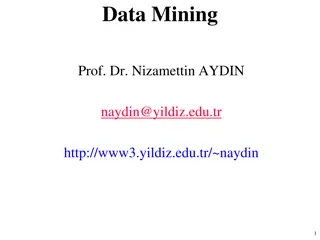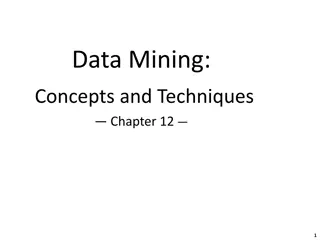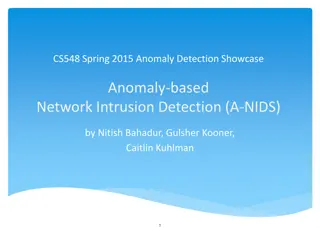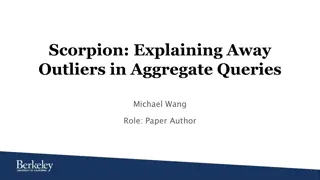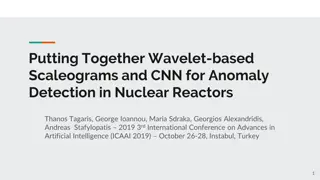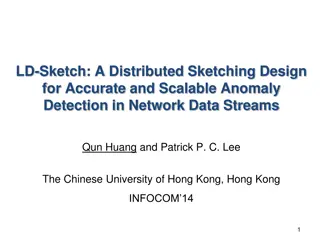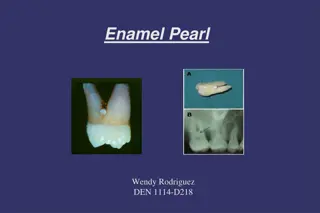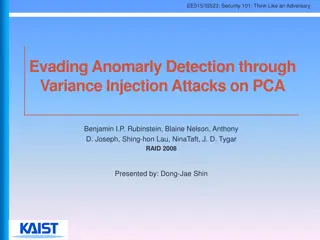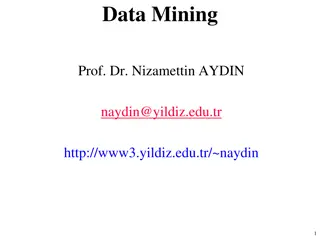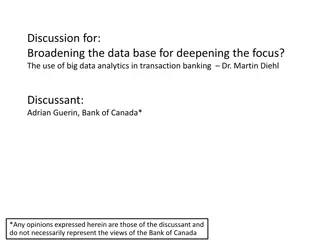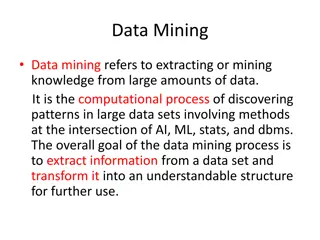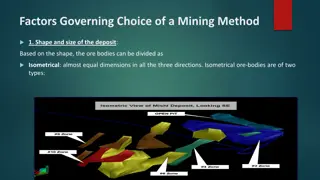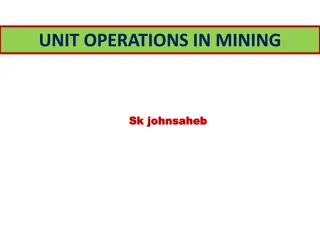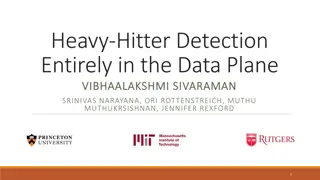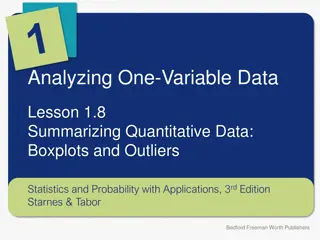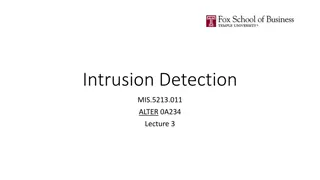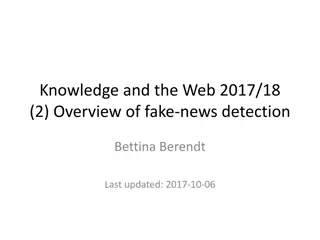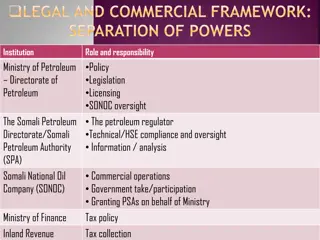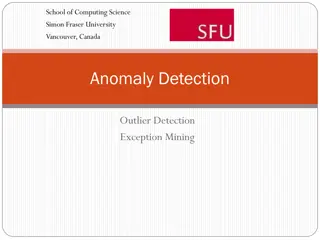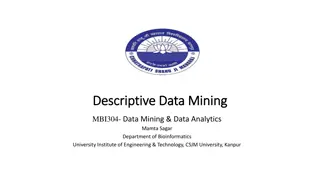Anomaly Detection in Data Mining: Understanding Outliers and Importance
Anomaly detection is crucial in data mining to identify data points significantly different from the norm. This technique helps in recognizing rare occurrences like ozone depletion anomalies. Understanding the distinction between noise and anomalies is key, as anomalies can provide valuable insights. Consideration of attributes and context is essential for effective anomaly detection.
Download Presentation

Please find below an Image/Link to download the presentation.
The content on the website is provided AS IS for your information and personal use only. It may not be sold, licensed, or shared on other websites without obtaining consent from the author. Download presentation by click this link. If you encounter any issues during the download, it is possible that the publisher has removed the file from their server.
E N D
Presentation Transcript
Anomaly Detection Lecture Notes for Chapter 9 Introduction to Data Mining, 2nd Edition by Tan, Steinbach, Karpatne, Kumar Introduction to Data Mining, 2nd Edition 9/27/2024 1
Anomaly/Outlier Detection What are anomalies/outliers? The set of data points that are considerably different than the remainder of the data Natural implication is that anomalies are relatively rare One in a thousand occurs often if you have lots of data Context is important, e.g., freezing temps in July Can be important or a nuisance 10 foot tall 2 year old Unusually high blood pressure 9/27/2024 Introduction to Data Mining, 2nd Edition 2
Importance of Anomaly Detection Ozone Depletion History In 1985 three researchers (Farman, Gardinar and Shanklin) were puzzled by data gathered by the British Antarctic Survey showing that ozone levels for Antarctica had dropped 10% below normal levels Why did the Nimbus 7 satellite, which had instruments aboard for recording ozone levels, not record similarly low ozone concentrations? The ozone concentrations recorded by the satellite were so low they were being treated as outliers by a computer program and discarded! Sources: http://exploringdata.cqu.edu.au/ozone.html http://www.epa.gov/ozone/science/hole/size.html Introduction to Data Mining, 2nd Edition 9/27/2024 3
Causes of Anomalies Data from different classes Measuring the weights of oranges, but a few grapefruit are mixed in Natural variation Unusually tall people Data errors 200 pound 2 year old Introduction to Data Mining, 2nd Edition 9/27/2024 4
Distinction Between Noise and Anomalies Noise is erroneous, perhaps random, values or contaminating objects Weight recorded incorrectly Grapefruit mixed in with the oranges Noise doesn t necessarily produce unusual values or objects Noise is not interesting Anomalies may be interesting if they are not a result of noise Noise and anomalies are related but distinct concepts Introduction to Data Mining, 2nd Edition 9/27/2024 5
General Issues: Number of Attributes Many anomalies are defined in terms of a single attribute Height Shape Color Can be hard to find an anomaly using all attributes Noisy or irrelevant attributes Object is only anomalous with respect to some attributes However, an object may not be anomalous in any one attribute Introduction to Data Mining, 2nd Edition 9/27/2024 6
General Issues: Anomaly Scoring Many anomaly detection techniques provide only a binary categorization An object is an anomaly or it isn t This is especially true of classification-based approaches Other approaches assign a score to all points This score measures the degree to which an object is an anomaly This allows objects to be ranked In the end, you often need a binary decision Should this credit card transaction be flagged? Still useful to have a score How many anomalies are there? Introduction to Data Mining, 2nd Edition 9/27/2024 7
Other Issues for Anomaly Detection Find all anomalies at once or one at a time Swamping Masking Evaluation How do you measure performance? Supervised vs. unsupervised situations Efficiency Context Professional basketball team Introduction to Data Mining, 2nd Edition 9/27/2024 8
Variants of Anomaly Detection Problems Given a data set D, find all data points x D with anomaly scores greater than some threshold t Given a data set D, find all data points x D having the top-n largest anomaly scores Given a data set D, containing mostly normal (but unlabeled) data points, and a test point x, compute the anomaly score of x with respect to D Introduction to Data Mining, 2nd Edition 9/27/2024 9
Model-Based Anomaly Detection Build a model for the data and see Unsupervised Anomalies are those points that don t fit well Anomalies are those points that distort the model Examples: Statistical distribution Clusters Regression Geometric Graph Supervised Anomalies are regarded as a rare class Need to have training data Introduction to Data Mining, 2nd Edition 9/27/2024 10
Additional Anomaly Detection Techniques Proximity-based Anomalies are points far away from other points Can detect this graphically in some cases Density-based Low density points are outliers Pattern matching Create profiles or templates of atypical but important events or objects Algorithms to detect these patterns are usually simple and efficient Introduction to Data Mining, 2nd Edition 9/27/2024 11
Visual Approaches Boxplots or scatter plots Limitations Not automatic Subjective Introduction to Data Mining, 2nd Edition 9/27/2024 12
Statistical Approaches Probabilistic definition of an outlier: An outlier is an object that has a low probability with respect to a probability distribution model of the data. Usually assume a parametric model describing the distribution of the data (e.g., normal distribution) Apply a statistical test that depends on Data distribution Parameters of distribution (e.g., mean, variance) Number of expected outliers (confidence limit) Issues Identifying the distribution of a data set Heavy tailed distribution Number of attributes Is the data a mixture of distributions? Introduction to Data Mining, 2nd Edition 9/27/2024 13
Normal Distributions One-dimensional Gaussian 8 7 0.1 6 0.09 5 0.08 4 Two-dimensional Gaussian 0.07 3 0.06 2 0.05 1 y 0.04 0 0.03 -1 0.02 -2 -3 0.01 -4 probability density -5 -4 -3 -2 -1 0 1 2 3 4 5 x Introduction to Data Mining, 2nd Edition 9/27/2024 14
Assessing Statistical Significance An object with attribute value x from a Gaussian distribution with mean of 0 and standard deviation 1 is an outlier if, |X| ?, where x is a constant chosen so that ? ? ? = ? (? specifies the degree of rareness) More generally, for a Gaussian distribution with mean ? and standard deviation ?, first z score of x can be first computed and then apply the same test on x. Ye 2020 Introduction to Data Mining, 2nd Edition 9/27/2024 15
Grubbs Test Detect outliers in univariate data Assume data comes from normal distribution Take into account the distortion of parameter estimates caused by outliers Detects one outlier at a time, remove the outlier, and repeat H0: There is no outlier in data HA: There is at least one outlier Grubbs test statistic: N max X X = G s 2 t ( ) 1 N G ( / + , 2 ) N N t 2 2 N Reject H0 if: ( / , 2 ) N N Introduction to Data Mining, 2nd Edition 9/27/2024 16
Statistical-based Likelihood Approach Assume the data set D contains samples from a mixture of two probability distributions: M (majority distribution) A (anomalous distribution) General Approach: Initially, assume all the data points belong to M Let Lt(D) be the log likelihood of D at time t For each point xt that belongs to M, move it to A Let Lt+1 (D) be the new log likelihood. Compute the difference, = Lt(D) Lt+1 (D) If > c (some threshold), then xt is declared as an anomaly and moved permanently from M to A Introduction to Data Mining, 2nd Edition 9/27/2024 17
Statistical-based Likelihood Approach Data distribution, D = (1 ) M + A M is a probability distribution estimated from data Can be based on any modeling method (na ve Bayes, maximum entropy, etc) A is initially assumed to be uniform distribution Likelihood at time t: N = = i x i x A = = M | | | | A ( ) ( ) 1 ( ) ( ) ( ) L D P x P x P x t t t D i M i A i t t 1 i M A t t i x i x + + + ( ) log( 1 ) log ( ) log log ( ) LL D M P x P x t t M i t A i t t M A t t Introduction to Data Mining, 2nd Edition 9/27/2024 18
Strengths/Weaknesses of Statistical Approaches Firm mathematical foundation Can be very efficient Good results if distribution is known In many cases, data distribution may not be known For high dimensional data, it may be difficult to estimate the true distribution Anomalies can distort the parameters of the distribution Introduction to Data Mining, 2nd Edition 9/27/2024 19
Distance-Based Approaches Several different techniques An object is an outlier if a specified fraction of the objects is more than a specified distance away (Knorr, Ng 1998) Some statistical definitions are special cases of this The outlier score of an object is the distance to its kth nearest neighbor Introduction to Data Mining, 2nd Edition 9/27/2024 20
Distance-based approach The outlier score of an object is the distance to its kth nearest neighbor What s the right k? Ye 2020 Introduction to Data Mining, 2nd Edition 9/27/2024 21
One Nearest Neighbor - One Outlier D 2 1.8 1.6 1.4 1.2 1 0.8 0.6 0.4 Outlier Score Introduction to Data Mining, 2nd Edition 9/27/2024 22
One Nearest Neighbor - Two Outliers 0.55 D 0.5 0.45 0.4 0.35 0.3 0.25 0.2 0.15 0.1 0.05 Outlier Score Introduction to Data Mining, 2nd Edition 9/27/2024 23
Five Nearest Neighbors - Small Cluster 2 D 1.8 1.6 1.4 1.2 1 0.8 0.6 0.4 Outlier Score Introduction to Data Mining, 2nd Edition 9/27/2024 24
Five Nearest Neighbors - Differing Density D 1.8 1.6 1.4 1.2 1 0.8 0.6 0.4 0.2 Outlier Score Introduction to Data Mining, 2nd Edition 9/27/2024 25
Strengths/Weaknesses of Distance-Based Approaches Simple Expensive O(n2) Sensitive to parameters Sensitive to variations in density Distance becomes less meaningful in high- dimensional space Introduction to Data Mining, 2nd Edition 9/27/2024 26
Density-Based Approaches Density-based Outlier: The outlier score of an object is the inverse of the density around the object. Can be defined in terms of the k nearest neighbors One definition: Inverse of distance to kth neighbor Another definition: Inverse of the average distance to k neighbors DBSCAN definition If there are regions of different density, this approach can have problems Introduction to Data Mining, 2nd Edition 9/27/2024 27
Relative Density Consider the density of a point relative to that of its k nearest neighbors Introduction to Data Mining, 2nd Edition 9/27/2024 28
Relative Density Outlier Scores 6.85 6 C 5 4 1.40 D 3 1.33 2 A 1 Outlier Score Introduction to Data Mining, 2nd Edition 9/27/2024 29
Density-based: LOF approach For each point, compute the density of its local neighborhood Compute local outlier factor (LOF) of a sample p as the average of the ratios of the density of sample p and the density of its nearest neighbors Outliers are points with largest LOF value In the NN approach, p2 is not considered as outlier, while LOF approach find both p1 and p2 as outliers p2 p1 Introduction to Data Mining, 2nd Edition 9/27/2024 30
Strengths/Weaknesses of Density-Based Approaches Simple Expensive O(n2) Sensitive to parameters Density becomes less meaningful in high- dimensional space Introduction to Data Mining, 2nd Edition 9/27/2024 31
Clustering-Based Approaches Clustering-based Outlier: An object is a cluster-based outlier if it does not strongly belong to any cluster For prototype-based clusters, an object is an outlier if it is not close enough to a cluster center For density-based clusters, an object is an outlier if its density is too low For graph-based clusters, an object is an outlier if it is not well connected Other issues include the impact of outliers on the clusters and the number of clusters Introduction to Data Mining, 2nd Edition 9/27/2024 32
Distance of Points from Closest Centroids 4.5 4.6 4 C 3.5 3 2.5 D 0.17 2 1.5 1.2 1 A 0.5 Outlier Score Introduction to Data Mining, 2nd Edition 9/27/2024 33
Relative Distance of Points from Closest Centroid 4 3.5 3 2.5 2 1.5 1 0.5 Outlier Score Introduction to Data Mining, 2nd Edition 9/27/2024 34
Strengths/Weaknesses of Distance-Based Approaches Simple Many clustering techniques can be used Can be difficult to decide on a clustering technique Can be difficult to decide on number of clusters Outliers can distort the clusters Introduction to Data Mining, 2nd Edition 9/27/2024 35


